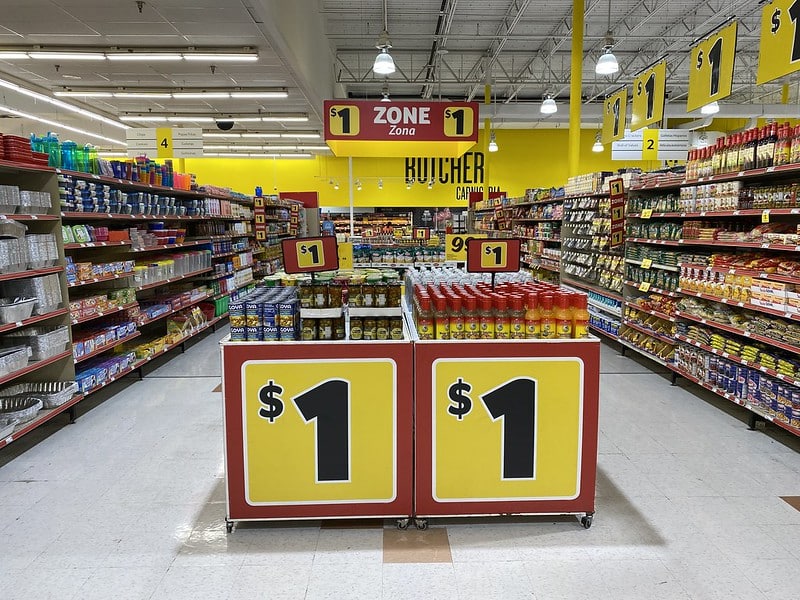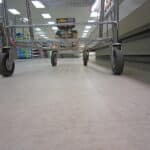
You want to find deals at the grocery store. But do you want your grocery store to look like a bazaar, with pyramids of promoted products and bins of discounted goods everywhere you turn?
For many stores and shoppers, a new report says those days may be behind us. Less-cluttered aisles might make for a streamlined, more pleasant grocery shopping experience – but they could come at a cost.
The market research firm IRI has taken a look at “in-store display merchandising trends” in grocery stores. And the trend seems to be – much less of it. Fewer bins, fewer product displays, fewer endcaps filled with sale items.
It started during the coronavirus pandemic, IRI noted, when “grocery retailers scrambled to create a safe shopping environment for social-distancing customers.” IRI first highlighted this in a related report back in 2020, when it observed that “efforts to accommodate social distancing have significantly cut into retailers’ display space.” In addition, stores simply didn’t need all of that promotional space. “Why promote what you can’t guarantee will be on the shelves, especially at a time when shoppers didn’t need incentives to make a purchase?” IRI asked.
Now that we’re past the height of the pandemic, everyday life has largely returned to normal. But in-store promotional displays haven’t. IRI estimates that the average grocery store has ten fewer displays now than it did before the pandemic.
And that’s a problem, because those displays are where stores put the stuff that’s on sale.
“Consumers have learned to live with the pandemic,” IRI’s report reads. But “increasing inflation has them searching for deals.” And many deal-seekers might welcome cluttered stores right about now.
Shoppers told IRI that they’re looking for more deals – but not having much luck finding them. Last year at this time, 45% of those surveyed said they’re increasingly likely to look for more sales or deals. This year, that percentage has risen to 55%. But more than half also say “fewer of the items I want are on sale,” and a similar percentage say “the items on sale aren’t discounted as much.”
And fewer displays could be part of the problem, the report noted, since “fewer displays result in less frequent features.” Manufacturers may not be willing to work with retailers to offer promotional prices on their products if they can’t get featured, high-visibility displays. Or maybe their products are actually on sale, but shoppers don’t know it, because there are no displays available to promote them.
Of course, the savvy shopper knows that a display of items doesn’t necessarily mean those items are on sale. In 2020, IRI found that many store displays featured “sanitizing products such as bleach, cleaning wipes and soap,” and other “categories uniquely suited to quarantine” – all of them sold at full price. These items were already in high demand, so there was no need to put them on sale. Instead, the space was repurposed, from promotion to prominence – making in-demand items easier for shoppers to find.
Today, with inflation a greater concern for most grocery shoppers than Covid, there are few items in such high demand that shoppers are willing to pay full price. Instead, what shoppers want are deals.
So “as display space shrinks, CPG manufacturers must work with retailers to drive more incremental opportunity via displays,” IRI concludes. In other words, brands and retailers need to make sure the displays that are still available, pack a bigger promotional punch. Otherwise, shoppers may start seeking out stores that are more cluttered – with savings.
Image source: Phillip Pessar











Paging Harris Teeter! You clearly didn’t get the message.
There’s more clutter than ever in your already narrow aisles. Annoying angled mid-aisle displays filled with breakables. Which often get knocked off, break, and leave a sticky, greasy, gooey mess on the already dirty floors.
And then there are the end-cap extenders that further narrow the already narrow aisles.
Clear the clutter!
PS — I’d give a shout out to Dollar Tree, too, but that’s a lost cause.
Kroger does love clutter! Other stores must have gotten pretty clean to skew the average like this. And Dollar Tree… that’s a whole different story.